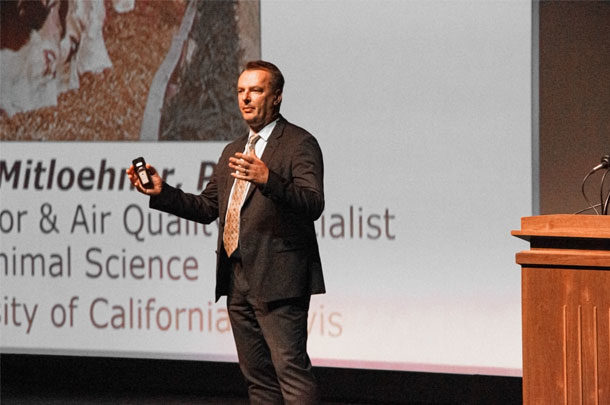He prefaced his presentation with a reminder to producers to keep an open mind when addressing consumer and/or activist concerns about the effects of animal agriculture on climate change. “No matter how you feel about things politically,” he said. “Just educate yourself, and listen to what people have to say and what the markets have to say.”
Global warming is real
“What climate scientists will tell you is that human activity has something to do with [global warming]. Yes, climate has always changed, there have always been periods of heating and cooling throughout history, but what we see now is more of a uniform heating that concerns them,” he said. Carbon dioxide (CO2), methane gasses and nitrous oxide are the main greenhouse gasses that are being discussed, particularly around food production.
These three gasses are often discussed in terms of their global warming potential, meaning their ability to trap heat from the sun, which causes global warming. Mitloehner compared this measurement to putting coffee in a Styrofoam cup, a china cup and an insulated mug, and comparing how long each container can keep the coffee warm. CO2 has the lowest global warming potential, methane gas is 28 times more potent in trapping heat from the sun and nitrous oxide is 300 times more potent than CO2.
This is where the story ends for most activists. “They see that methane is 28 times more potent than CO2, thus, all sources emitting methane should be regulated,” Mitloehner said. “In my opinion, the methane question is the Achilles’ heel of ruminant livestock production today.”
The main human activity contributing to human-caused greenhouse gasses is the production of CO2 through the use of fossil fuels, but activists continue to lay the blame on livestock production and methane gasses. Mitloehner said that globally, there are 560 teragrams of methane produced [each year], and at seeing this number, activists will insist that all sources of methane, including livestock production, be regulated.
But methane, unlike CO2, is broken down through a natural process called hydroxyl oxidation. “There are so-called radicals in the air, these are molecules, and once they get acquainted with methane, they steal one of the hydrogen atoms in the methane away, and by doing so, they destroy the methane,” he explained.
Once released into the atmosphere, CO2 stays there for 1,000 years before being destroyed. Methane lasts 10 years before being used. “If you look at the numbers, methane is produced at 560 teragrams and consumed at 550 teragrams,” he said. “This information is critically important, and it is totally missing from today’s discussions about methane sources and what we should do with those sources.” Focusing on the ag industry and methane gas instead of other industries that generate the more problematic CO2 is just one example of activists and even concerned consumers taking a piece of misinformation and running with it.
Maintaining methane emissions
“Our cattle industry, whether it’s dairy or beef, has not added additional methane to the atmosphere for a very long time.” Mitloehner said that during the time of European settlement of North America, there were 80 million bison in this country. They were replaced by 90 million beef cattle. “The amount of methane that came from those bison back in 1850 is not dissimilar to the amount of methane that is produced by our cattle today. I would say that most likely, we have not added additional biochemical methane to the atmosphere in a very long time.”
Takeaway facts
Breakdown of U.S. greenhouse gas emissions in 2016:
- 82% CO2
- 10% methane
- 6% nitrous oxide
- 3% fluorinated gasses
Breakdown of U.S. greenhouse gas emissions in 2016 by economic sector:
- 28% Transportation
- 28% Electricity generation
- 22% Industry
- 9% Agriculture
- 6% Commercial
- 5% Residential
Follow Mitloehner on Twitter.
PHOTO: Dr. Frank Mitloehner believes the questions surrounding methane gas are the Achilles’ heel of the livestock industry. Photo by Carrie Veselka.

-
Carrie Veselka
- Editor
- Progressive Cattle
- Email Carrie Veselka





